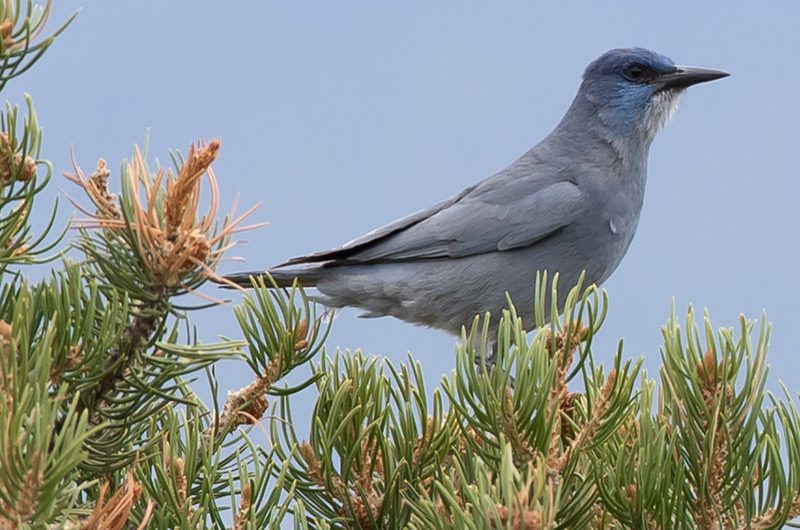LandPKS Learning
Habitat Hub

Pinyon Jay
Pinyon jays have an excellent spatial memory, likely because they are dependent on pinyon pine seeds for winter survival and an early breeding season. They cache seeds in leaf/needle litter and tree crevices and can find them later in the season without any apparent clues to the human eye. An individual bird can store around 2,600 seeds in the fall, while a flock of 250 birds can store up to 4.5 million seeds! Pinyon jays can also carry up to 40 seeds at a time in their throat to help them cache more seeds for the winter.
Gymnorhinus cyanocephalus
Identification
The pinyon jay is a medium-sized bird (10-11 in/26-29 cm in length), similar in size to a robin, with a short tail and long, sharp bill. Males and females look similar with dull blue coloring except for a whitish chin, throat, and breast. Males have a slightly darker blue head than females.
Observation Tips
Pinyon jays travel in large, noisy flocks year-round and reside in the same range year-round. Look for them feeding in pinyon-juniper stands or scrub-oak woodlands throughout the western U.S., and listen for their crow-like kaw’s, which they use to maintain contact with the group.
Interesting Fact
Pinyon jays have an excellent spatial memory, likely because they are dependent on pinyon pine seeds for winter survival and an early breeding season. They cache seeds in leaf/needle litter and tree crevices and can find them later in the season without any apparent clues to the human eye. An individual bird can store around 2,600 seeds in the fall, while a flock of 250 birds can store up to 4.5 million seeds! Pinyon jays can also carry up to 40 seeds at a time in their throat to help them cache more seeds for the winter.
Ideal Habitat
Pinyon jays mostly use pinyon-juniper woodlands, but flocks may also breed in sagebrush, scrub oak, chaparral, ponderosa, and Jeffrey pine forests. They prefer mature pinyon woodlands, as they produce more seeds. Pinyon jays will occupy the same home range if habitat conditions are suitable; otherwise, they will travel to new locations looking for seeds. Pinyon jays mainly nest in pinyon-juniper woodlands with 15-35% canopy cover but use different tree species depending on location. Tree species include Colorado pinyon, single-needle pinyon, one-seed juniper, Utah juniper, alligator juniper, and Rocky Mountain juniper.

Range map provided by BirdLife International
Management Activities that Benefit Species – Best Management Practices (BMPs)
To promote pinyon jay habitat, retain mature pinyon or pinyon-juniper woodland patches of at least 4480 ac/1813 ha, the approximate area of a flock’s home range. Retain large trees, which are the most prolific cone producers, because successful breeding is closely tied to pinyon pines and seed production. Where possible, note nesting bird sites to avoid disturbance during nesting. If thinning pinyon-juniper woodlands for fuels reduction, only thin areas with >35% canopy cover, and retain between 15-35% cover where possible. Remove slash piles, which provide winter hibernacula for beetles that can kill pinyon trees.
Management Activities to Avoid
Avoid developing roads, trails, or other sources of disturbance, such as oil and gas wells, no closer than 0.6 mi/1 km from known nesting sites because breeding colonies are sensitive to human disturbance. Also, avoid thinning or burning pinyon-juniper woodlands in areas with nesting pinyon jays. Avoid thinning pinyon-juniper woodlands if canopy cover is <15%.
Other Species that Benefit from Similar Habitat Management
Other species that may benefit from habitat management for pinyon jays include juniper titmouse, ash-throated flycatcher, gray vireo, and gray flycatcher.
Download
Download the Pinyon Jay factsheet
Other Resources
BirdLife International and Handbook of the Birds of the World. 2019. Bird species distribution maps of the world. Version 2019.1. Pinyon Jay
The Cornell Lab of Ornithology, Birds of the World Pinyon Jay
The Cornell Lab of Ornithology. All About Birds Pinyon Jay
Gillihan, SW. 2006. Partners in Flight Western Working Group. Sharing the land with pinyon-juniper birds. Salt Lake City, UT. 43 pp.
Photo credit: John Mangold/Flickr
Mobile App | Data Portal | Knowledge Hub | Habitat Hub | Learning Collections | Blog | About | Contact | Support



